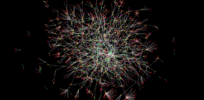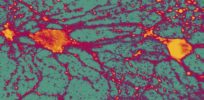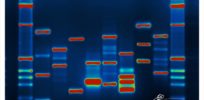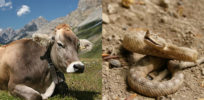National Geographic
First avian pollinator discovered: 47 million years old
The discovery, uncovered in Germany's fossil-rich Messel Pit, reveals a three-inch-long (eight-centimeter) bird—about the size of a hummingbird you see ...
Marmosets offer clue to human stillbirths, programmed while mom is in grandma’s womb
One way to learn about reproductive health is to observe how our primate cousins have babies. And a new study ...
Hawaiian crickets escape parasite through gene mutations that keep them quiet
The crickets hadn’t disappeared. Marlene Zuk would go for nighttime walks and see multitudes of the insects in the light ...
Connection between pain and aging may lead through matabolic genes
Age brings pain: back pain, eye strain, sore joints, and the like. And pain, too, seems to accelerate aging. Several ...
One man’s junk: What non-coding DNA really means
Genomes are like books of life. But until recently, their covers were locked. Finally we can now open the books ...
Insects pass infections to their progency through sperm and eggs
The green rice leafhopper is never alone. When a female’s egg and a male’s sperm fuse into a new cell, ...
Cell biologist Rebecca Rupp: I’m pro-GMO and here’s why
We all know that there are topics that are best to avoid at public dinners. Religion and politics usually top ...
How do you study the evolution of intelligence: look to animals
There are many scientists who study the mental abilities of animals. As intelligent animals ourselves, we’re keen to learn whether ...
How to feed a world with 9 billion people in 5 steps
When we think about threats to the environment, we tend to picture cars and smokestacks, not dinner. But the truth ...
Investigating the microbiomes of modern hunters and gatherers
It is now abundantly clear that the microbes that live in our bodies are critical parts of our lives and ...
Viral infections gave Strep bacteria killer genes
By examining decades' worth of stored bacteria samples, researchers have determined how a benign organism evolved into a deadly pathogen ...

How much of our genome do we share with other organisms? Take this quiz.
Find out how much genetic material humans share with grapes, round worms and dogs ...
Publishing bird flu results remains controversial due to threat of biological weapon development
When does scientific research cause more harm than good? That question has been at the heart of controversy over what ...
Genographic team surveys New Zealand
The Genographic Team has been in New Zealand this week, working with people of Pacific as well as European and ...

Finding more disease genes, faster
Researchers string together disease genes to create networks that help explain the interactions between the genes, and, better yet, find ...

Old brains may be slow, but still smart
Modern memory tests are selling old brains short. It could be that older, wiser heads are so chock full of ...

Surprise: Ancient europeans had dark skin and blue eyes
Ancient Europeans may have been dark-skinned and blue-eyed (a combination rarely found in modern times) according to DNA from a ...

Extinguishing the memory of fear, with a drug that changes the epigenome
A new drug changes the chemical markers that attach to DNA, making it possible to treat even old traumatic memories ...
Scientists wrong in linking gene to whale and dolphin brain evolution
In 2012, a team of Chinese scientists showed that a gene called ASPM has gone through bouts of accelerated evolution ...

My risk-benefit ratio for personal genetics
Personal genomics is going to play a role in future medical care. If 23andMe can't provide medical results to customers, ...
Evolution from water to land, bone by bone
Travel back far enough in your genealogy, and you will run into a fish. Before about 370 million years ago, ...

E. coli: still showing us new evolutionary tricks after a century
It’s hard to believe that Escherichia coli could have any secrets left. For over a century, scientists have picked the ...
Advances in using tailored cell cultures to test genetic disease treatments
Here’s a vision of the future. You’re diagnosed with a rare genetic disorder. Your doctors take a sample of your ...
Idea of genetic mosaicism hits psychiatry
The title of my blog post is provocative, I know, but I’m actually just lifting it from the title of ...

Bioethical questions arise from advances in neuroscience
A new article looks at the five biggest potential moral and ethical dilemmas that might arise from recent advances in ...

Comparison of aging patterns sheds light on evolutionary purpose of aging
A new comparison of aging patterns of humans and 45 other species reveals that some species live much longer than ...

Nearly a quarter of cow genome comes from snakes
According to a new article, “horizontal gene transfer” allows genes to cut themselves out of surrounding DNA and paste themselves ...

Is same-sex coupling a matter of genetics or choice?
A new report has found that nearly a third of Laysan albatross pairs on Oahu are of the same gender, ...

